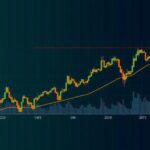Bitcoin Dips Below $60K as Markets Anticipate Fed Rate Cut
Summary
Bitcoin’s price has fallen below $60,000 ahead of a highly anticipated Federal Reserve interest rate cut, which traders view as a possible economic concern. Currently priced at approximately $59,900, Bitcoin has increased 1.3% over the last day despite a broader market decline. Analysts view Ether as a potential investment opportunity, and BitGo plans to launch a unique dollar-backed stablecoin emphasizing liquidity rewards. Binance experiences significant trading volume for Bitcoin, possibly indicating short-term price adjustments.
In the midst of a significant event, the price of Bitcoin has dipped below $60,000 as anticipation builds for the Federal Reserve’s first interest rate cut in four years, scheduled for later today. Historically, lower interest rates tend to positively impact risk assets, including cryptocurrencies. However, traders are currently estimating a 65% likelihood of a 50 basis-point reduction, which may inadvertently signal economic concern rather than optimism. As of the latest figures, Bitcoin is trading at approximately $59,900, reflecting a 1.3% rise over the past 24 hours, although the broader digital asset market, represented by the CoinDesk 20 Index, has experienced a decline of about 0.7%. Amidst this backdrop, Ether has shown a lackluster performance during 2024, yet analysts from Bitwise suggest that it could represent a contrarian investment opportunity going into the end of the year. Despite Ethereum’s relative stagnation, it continues to dominate as the primary platform for stablecoins and decentralized finance, holding 60% of all DeFi assets. Matt Hougan, Chief Investment Officer at Bitwise, draws a comparison between Ethereum and Microsoft; while other tech companies may currently generate more excitement, Microsoft remains a foundational and influential entity in the sector. Furthermore, cryptocurrency custodian BitGo plans to launch a new dollar-backed stablecoin, USDS, in the coming year. This stablecoin aims to distinguish itself from competitors by offering rewards to institutions that contribute liquidity. It will be supported by short-term Treasury bills and cash reserves. CEO Mike Belshe elaborated on the mechanism, stating that monthly returns generated from the reserves will be distributed to liquidity providers proportionally based on their asset custody. A notable observation from recent trading activity demonstrates that Binance, the largest cryptocurrency exchange globally, has recorded its highest Bitcoin spot trading volume in three months. Historical trends indicate that similar spikes in trading volume often precede a temporary slowdown in Bitcoin prices.
The cryptocurrency market, particularly Bitcoin, has historically reacted to changes in interest rates set by the Federal Reserve. Lower interest rates typically enhance the appeal of risk assets such as cryptocurrencies by reducing borrowing costs and encouraging speculative investments. As the Fed prepares to announce a significant shift in monetary policy, the market is closely monitoring potential impacts on asset valuations. Additionally, the competitive landscape for digital assets is evolving, with new offerings like stablecoins seeking to capture market share by appealing to liquidity providers and institutional participants. Understanding these dynamics is essential for investors navigating this continually shifting financial environment.
In conclusion, Bitcoin’s recent decline below the $60,000 threshold coincides with pivotal developments in U.S. monetary policy as the Federal Reserve approaches its interest rate cut announcement. While Bitcoin sees a modest increase, the overall crypto market shows signs of consolidation. Ether’s current position raises questions about its future direction despite its crucial role in the DeFi ecosystem. Furthermore, BitGo’s forthcoming stablecoin launch highlights the growing importance of liquidity incentives among crypto institutions. Observations from trading behaviors on major exchanges, such as Binance, underscore the complexities of market trends and potential price fluctuations.
Original Source: www.coindesk.com








Post Comment